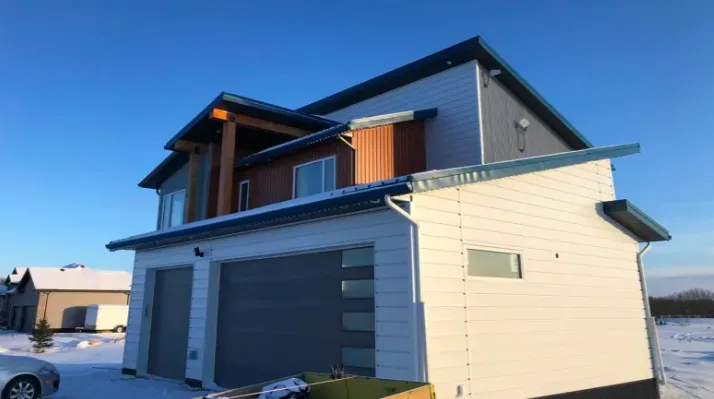
Alberta cold snap no match for the furnace-free warmth of a net-zero home
A polar vortex brought bitterly cold temperatures to Alberta this week, but thanks to the sunny weather through this cold snap, Darryl Zubot was cosy and warm inside his house without needing to fire up a furnace.
Zubot and his family live in a home that has been designed to be net-zero. Once its solar panels are installed this spring, the home will produce as much energy as it consumes, thanks to a suite of features — like massive triple-paned windows, additional insulation, extra-efficient appliances and a heat pump — that decrease its energy use.
Every year, the amount of energy the house generates and uses should cancel each other out.
Zubot used to live in a cold, poorly insulated house on an acreage. When his family was looking to build a new house in Leduc County, south of Edmonton, he was interested in energy efficiency and building something more environmentally friendly.

Darryl Zubot's house in Leduc County is designed to produce as much energy as it uses. (Supplied by Darryl Zubot)
"I do follow climate change quite a bit, and I definitely think we need to do our part to reduce our oil consumption," Zubot, told CBC Edmonton's Radio Active this week. "I know it's not going to change overnight and we still need oil, but it's definitely slowly transitioning."
Zubot also owns an aerial survey company, which uses one of the most fuel-efficient aircraft in the world, the Pipistrel Virus SW.
"This house is a testament to how you can be completely self-sufficient in this day and age with no reliance on oil and gas."
Zubot said he and his wife Denae drew up the design they wanted for their house, then worked with De Waal Developments in Edmonton on these plans.
Once a 15-kilowatt solar energy system is installed on the roof later this year, the Zubots will be able to produce their own electricity. Like many net-zero homes, the house is connected to the regular power grid, which allows them to sell excess electricity through Alberta Co-operative Energy, as well as buy power when they need it.
As for the extended cold snap, Zubot said the bright sunny days went a long way toward keeping the family toasty.
Four south-facing windows, made of triple-paned glass and measuring six feet by 10 feet, provide about 30 to 35 per cent of the home's heat, he said. The rest was supplemented by the home's heat pump, another feature that appears on many net-zero homes instead of a natural gas furnace.
The result is that when it was minus-30 outside this week, it was plus-23 indoors.
One barrier to designing and constructing net-zero homes is how expensive they can be. Zubot said building his home has been roughly $40,000 more expensive than it would have otherwise been. But he says the house will pay for itself in the long run.
"We plan to be here for a long time, and it'll pay back in the long run. It's definitely not a short-term investment game, but long-term it definitely pays off," Zubot said.
Rooftop solar power is on the rise, but Canada has yet to embrace its sunny ways Net-zero-energy home sits empty as builder struggles to find buyers Net-zero homes are becoming more familiar to Canadians and Dale Rott, part-owner of Effect Home Builders in Edmonton, expects changes to Canada's building codes that will see their popularity grow in the next decade.
It's not easy to frame savings from a net-zero home in terms of its impact on utility bills, said Rott. But he said the current school of thought is that it would take about 20 years for net-zero homeowners to recoup their investment.
That said, people who start inquiring about net-zero houses are usually motivated by the environmental impact and a desire to use less energy.
"They are aware of climate change and they have an ideological reason for [building a net-zero home]," Rott said. "It's not because of cost-savings on utilities and all that. We're not hearing that yet."
This article was originally published by CBC News.











